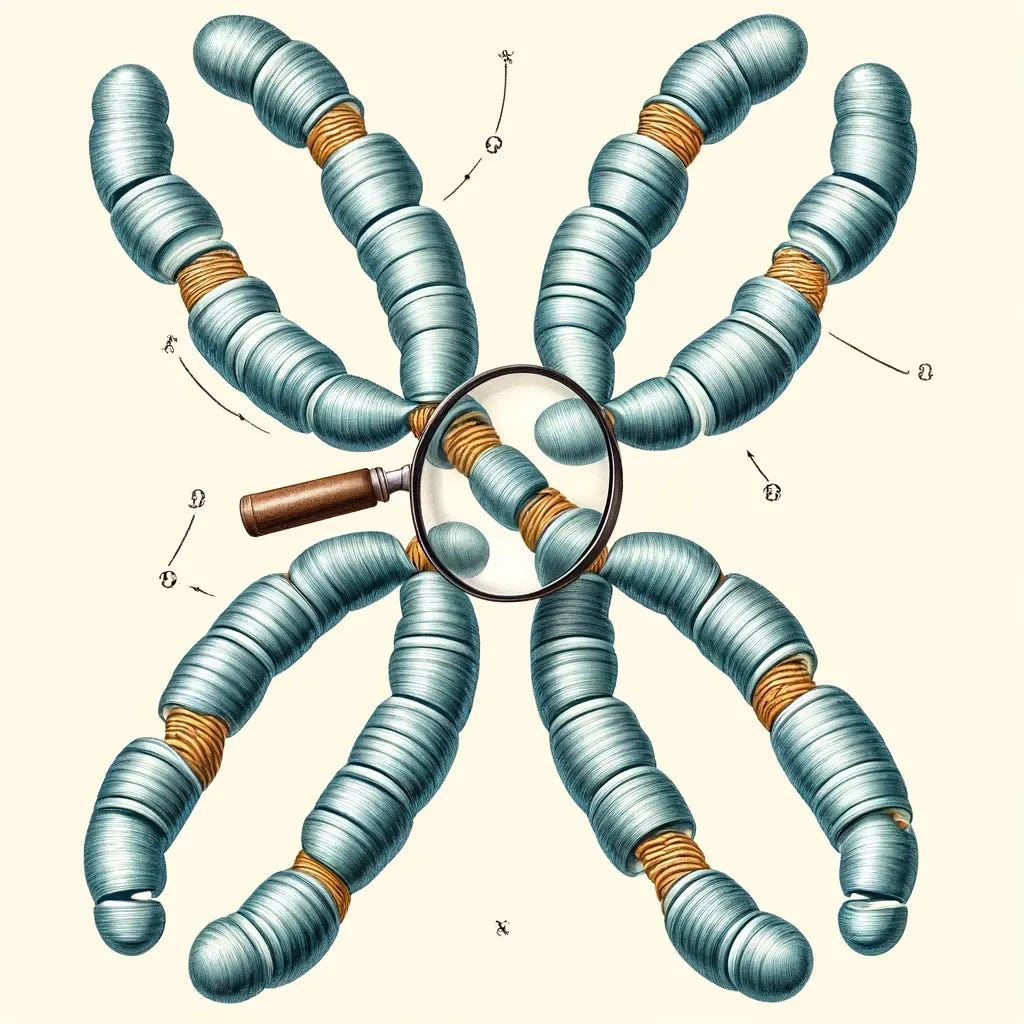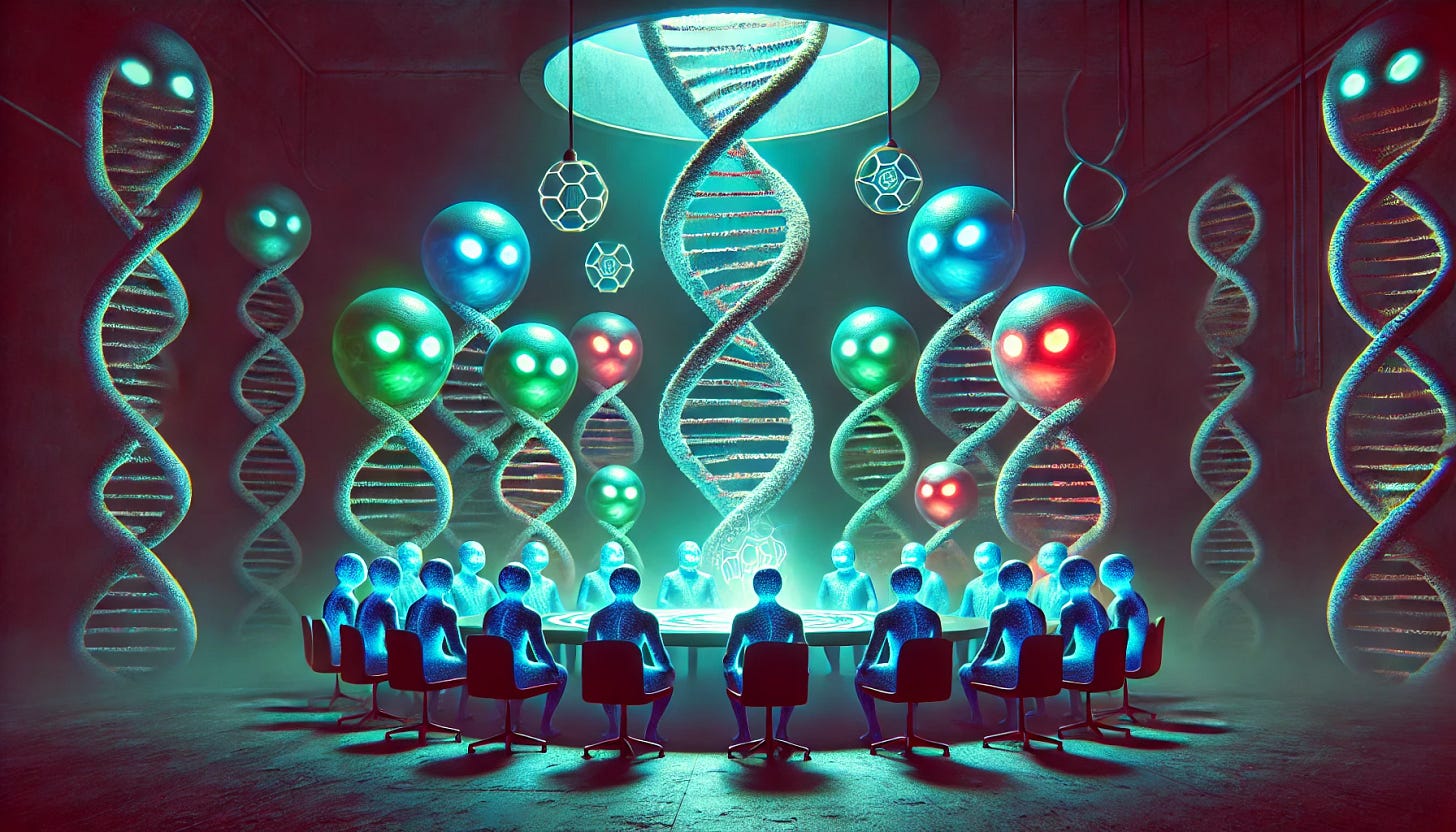2024 Project 8p Research Recap
Projects launched over the last 3 years have yielded foundational insights and key research capacity in 2024, bringing us one step closer to solving one of the most daunting whodunnits in medicine.
I probably wasn’t the only person who was roped into a fair share of board games this holiday season. I was reintroduced to the classic whodunnit mystery game Clue by my older son. As were were going around board taking turns, round after round of process of elimination that began aimlessly and gradually triangulated on the remaining possibilities, I confess my mind began to wonder.
I couldn’t shake the feeling that rare disease research is like a game of Clue — but much harder. Instead of solving a fictitious murder, the goal of Rare Clue is to identify the true mastermind behind a rare disease in a lineup of genetic suspects. This of course assumes there’s a lone wolf out there. For rare diseases caused by mutations in a single gene, that simplifying assumption is reasonable, even if it turns out that the biology of said gene is complex.
But a chromosomal disease is a tangled web of conspiracy: dozens or hundreds of so-called disease driver genes on an affected chromosome, some of which could cause a disease if mutated alone, not to mention the shadowy interactions between genes on 8p and genes on other chromosomes. It wasn’t just Miss Scarlett with a wrench in the ballroom. Or Professor Plum with a lead pipe in the study. It’s as though all the suspects were in cahoots, armed to the teeth with all the weapons, lurking in every room of the house.
Frustratingly, some of the suspects are red herrings, erecting roadblocks and diversions meant to throw researchers off the trail. And if we’re being completely candid, there are actually two intertwined conspiracies animating chromosomal diseases, as I mused earlier this year in a review on Substack.
The genes that are physically altered — losing or gaining a copy, or forcibly relocated to a different genomic address — constitute a network of so-called disease driver genes, or drivers for short. Elucidating the nodes, structure and hierarchy of that network is a prime focus for Project 8p. Unfortunately, the scientific challenge doesn’t end there.
The accompanying genomic imbalance that arises from megabase-scale chromosomal changes constitutes a second locus of disease pathology that is separate from the pathophysiological sequelae of tweaking the dosage of specific drivers. And just to make things even more interesting, consider the strong possibility that these two networks of conspirators could be active or lurking depending on the cell type, developmental timing, and conditional environmental stresses.
Below, I’ll highlight the incredible progress made by Project 8p sponsored research projects, highlighting four areas of discovery. We’ve worked with academic labs, CROs and biotech startups. We’ve interrogated 2-D and 3-D disease models in the dish. And with the successful launch of the 8p Health Canvas study at the 2024 Science and Family conference, we’re starting to bridge the gap between the lab and the real world.
Project 8p launched a collaboration with Prof Hiruy Meharena’s lab at UCSD to characterize induced pluripotent stem cell (iPSC) derived neuronal models using a suite of '“omics” approaches. We originally recruited the Meharena lab to the 8p cause based on intriguing results from studies of trisomy 21 cell models, which we hypothesized could be relevant for 8p. The Meharena lab was set up to investigate the convergences between chromosomal diseases, which often engender a similar set of symptoms in affected patients.
Note that two years ago we saw the first Reelin over-expression data from 3-D cortical brain organoids grown in Prof Alysson Muotri’s lab at UCSD that hinted at the possibility that the 8p disease state is not unique to 8p. So going into the collaboration with Meharena lab, we were already poised to see more examples of convergence between 8p and neurodevelopmental chromosomal diseases like Edwards Syndrome (Trisomy 18) and Patau Syndrome (Trisomy 13).
I don’t want to steal Meharena lab’s thunder since validation experiments on more 8p hero cell lines are needed for a peer-reviewed publication, and hopefully a preprint on the n-of-1 findings is in the works. So I’ll briefly recap here.
Gene expression analysis — aka transcriptomics or RNAseq — of neural progenitor cells (NPCs) derived from the iPSCs of a pioneer 8p invdupdel hero revealed a massively statistically significant overlap with NPCs derived from Trisomy 21 iPSCs even though two completely different chromosomes are affected. I don’t think I’ve ever seen a p-value that low.
Since that initial provocative data point, Meharena lab completed ATACseq and HiSeq, which tells us about genome-wide chromatin accessibility and 3-D genome architecture, respectively. They’ve also zoomed in on senescence, a zombie-like physiological state that cells enter when they’re sufficiently damaged or chronically stressed, which can occur when there’s genomic imbalance.
Meharena lab observes evidence of senescence in 8p NPCs, as well as concomitant metabolic changes that indicate that 8p NPCs are on the knife’s edge when it comes to cellular energy requirement. If these changes are happening because of 8p genomic imbalance per se rather than due to the effects of one or more 8p drivers, perhaps NPCs are uniquely vulnerable to aneuploidy in ways that other cell types aren’t.
The most obvious way to assess how much genomic imbalance is a conspiratorial force in 8p chromosomal diseases is to see what’s happening in other parts of the body and at different stages of life.
In parallel to the time-consuming and expensive disease modeling efforts in 2-D neurons and 3-D brain organoids, Project 8p booted up a research plank focused on the simplest and most cost effective human-derived cell model: fibroblasts, or skin cells. Prof Nicoleta Moisoi’s lab in the UK was recruited by Project 8p to characterize a set of four 8p hero fibroblast lines through a cell morphology lens using a high-content-imaging-based approach that built on the preliminary fibroblast phenotyping work started in the late Prof Angelika Amon’s lab at MIT.
The take-home message from the Moisoi lab’s work is that 8p hero fibroblast lines do indeed have cell morphological features that are distinct from age-matched and sex-matched healthy control fibroblasts. What’s more, 8p fibroblasts lines have increased sensitivity to DNA damage and reductions in mitochondrial membrane potential, which together suggest a chronic stress response to genomic imbalance, or aneuploidy, in 8p skin cells. But the intensity of these image-based phenotypes varied across the four 8p fibroblast lines.

With the Moisoi dataset in hand, we knew we had to expand the 8p fibroblast characterization campaign to a larger sample size as four was too small to draw meaningful conclusions. Fortuitously, I met Dr Max Wilson, one of the founders of a company called Integrated Biosciences, at a biotech reception in San Francisco a year ago. We knew each from our days at Princeton, he an undergraduate and I a postdoctoral fellow. If biotech’s a small world, the rare disease world is even smaller.
Integrated Biosciences is named after the integrated stress response, which was shown to be activated in fibroblasts from patients with Trisomy 21 (Down Syndrome), and led to an induction of premature senescence. The Meharena lab was independently investigating senescence in the brain, so it made sense for us to find a research partner that could examine the question of senescence using orthogonal, high-throughput cell-based assays and a totally different cell type.
Meeting Max was a case of perfect timing. Within a few weeks of reconnecting, Max, his cofounder Dr Felix Wong, and I hatched a scheme to characterize all of the 8p fibroblasts line in the Project 8p biobank. That number ended up being 13, and a similar number of healthy controls for comparison.
In the new year, I’ll write up a summary of the findings from the Integrated Biosciences partnership, so a teaser must suffice. Based on the Meharena lab’s result convergence in NPCs, we naively expected there to be similar convergence in fibroblasts, or at least robust integrated stress response pathway changes in all 8p fibroblasts, as was observed in Trisomy 21 fibroblasts.
Much to our surprise, 8p fibroblasts did not manifest any classical signs of integrated stress response (ISR) pathway over-activation or under-activation. All of the standard ISR modulators had no effect, good or bad, on 8p fibroblasts. For example, if 8p fibroblasts were experiencing classical senescence their growth would be sensitive to senolytics. Yet none of the senolytics tested on 8p fibroblast had any effect on 8p fibroblast viability.
Although a few 8p fibroblast lines shockingly stained positive for beta-gal, a colorimetric indictor of senescence, only a minority of cells in the culture actually turned blue. So we’re not sure whether the spotty senescence that was observed is an artifact of how that particular cell line was isolated and established in the lab. Staining for p21, a canonical marker of senescence, did not corroborate the beta-gal staining results.
Curiously, the majority of 8p fibroblasts exhibited decreased resistance to the mTOR inhibitor (and hoped for fountain of youth) rapamycin. Meaning a lower dose of rapamcyin was required to kill the same fraction of 8p fibroblasts compared to healthy fibroblasts. What it means is still anyone’s guess, but it’s steering us in the direction of metabolic interventions.
Some may call it a “negative result” but we learn from every well-designed experiment, including those with “negative” findings. Scientists assign a positive emotional valence when they get the result they expect or want, but assign a negative emotional valence when they get a no-effect, unexpected or confusing result. If we’re objectively sitting with the data, maybe the mental model of two interlocking conspiracies is not too far off the mark.
To a first approximation, we can conclude that the genomic imbalance caused by alterations and copy number changes to 8p is not equivalent of the genomic imbalance caused by having a third 21st chromosome, at least not in fibroblasts.
Not all genomic imbalance is equal, at least for any given cell type. But genomic imbalance, and the exacerbating effects of specific 8p (and non-8p) driver genes, do seem to matter when we’re talking about brain cells, specifically the neural progenitor cells (NPCs) whose descendants populate the brain with all of its neurons.
Perhaps 8p disease can be conceptualized by the two-hit model akin to tumorigenesis. An activating mutation in a single oncogene is not enough to convert a cell to cancerous, but activating mutations in two oncogenes, or an inactivating mutation in a tumor suppressor at the same time, is required for runaway growth. Extending that framework to chromosomal diseases, specific 8p driver genes alone or 8p genomic imbalance alone don’t drive most cells off the cliff, but the convergence of both forces in certain cells at certain times is the problem.
What if there were a way to decapitate the conspiracy without having to bring all the receipts and sort out who did what where? As a hedge but also as a nod to rapidly advancing genome editing technologies, Project 8p funded a proof-of-concept chromosome engineering project in Prof Jason Sheltzer’s lab at Yale, the first baby step in the lab toward what will one day hopefully mature into chromosome therapies in the clinic.
If we acknowledge the view that specific 8p driver genes and 8p genomic imbalance are colluding, then the most curative fix would be to surgically remodel or remove the entire damaged rearranged chromosome 8 in the cells of 8p heroes. Of course there will be cellular or tissue damage that won’t be immediately reversed by chromosome therapy especially the later in life such an intervention were to be administered. However, in theory, chromosome therapy alleviates the problem at its source, and the earlier in life the better. So it behooves Project 8p to place this speculative bet while simultaneously unraveling the web of conspiracies one strand at a time.

In the spirit of open science that animates Project 8p, Sheltzer lab has already posted a preprint summarizing their results. Briefly, Sheltzer lab was able to select for chromosomally corrected clones derived from a pioneer 8p invdupdel hero iPSC line. Chromosomally corrected means a derived clone from an 8p invdupdel hero iPSC line in which the rearranged maternal chromosome 8 was lost and replaced by a second copy of the un-rearranged paternal chromosome was gained.
To start, chromosomally corrected (also referred to as an isogenic control) iPSC lines are invaluable research assets because they are the best reference point or benchmark for an 8p hero iPSC line. Comparing a chromosomally corrected 8p iSPC line to its ancestral 8p hero iPSC line allows us to determine which changes, in this instance gene expression patterns, are the result of the 8p rearrangement because all other variables have essentially been held constant.
Thinking ahead many steps, there certainly will be delivery challenges associated with assembling the molecular equivalent of a chromosome surgical unit that can be safely deployed in actual humans. Would every cell in the body need to be chromosomally corrected or just the stem cells that give rise to differentiated daughter cells? It’s all pure science fiction today. But at least we’ve proved that it’s possible in a petri dish.
Lest you think all of Project 8p’s attention is solely focused on disease models that are ultimately still abstractions of actual 8 heroes, we started this year with an ambitious plan to involve 8p heroes and their families directly in research. We eventually named this initiative the 8p Health Canvas study, which I wrote about right after the 8p 2024 conference in Denver in July.

Since the conference, the science team at Project 8p has been sifting through many bytes of 8p hero data. Last month, a Project 8p Research Roundtable featured a discussion about the gut microbiome test called GI-MAP which was taken by at least 30 8p heroes. Reminiscent of the results from disease modeling in the lab, there is no universal 8p leaky gut or gut dysbiosis signature shared by all 8p heroes.
Instead we’re seeing a more fractal picture, where a few 8p heroes cluster together in subgroups whose defining features we still can’t discern. That said, we do indeed see evidence for distressed microbiomes and inflamed guts in 8p heroes, which are both clinically actionable in terms of diet optimization (i.e., removing gluten) and supplement stacks. A similar archipelago pattern of subgroups of 8p heroes is observed when we examine the MitoSwab results, which assess mitochondrial dysfunction.
Obviously, we’re working on a massive multi-variate analysis to start to untangle cause from effect and make the case for biologically justified 8p hero stratification. And we’re still awaiting results from Somalogic on 8p serum proteomics as well as genome-level assessments from Illumina. Slowly but surely, a first-of-its-kind and the most comprehensive genotype-phenotype database ever created for a chromosomal disease is coalescing.
I’ll end by spotlighting the 8p Health Canvas results from our collaboration with Unravel Biosciences. Working with Unravel’s rareSHIFT arm, we performed RNAseq on nasal swab samples collected from 8p heroes and a sex-matched sibling or parent for over 30 8p heroes to date (with more still in the queue). The goals of this segment of the 8p Health Canvas were twofold: stratify 8p heroes in buckets based on similar gene expression profiles and identify drug repurposing candidates in silico that normalize the 8p gene expression profile.
A fuller explication of the Unravel dataset is forthcoming in the new year. Suffice it to say, RNAseq on 8p hero nasal swab samples revealed that 8p heroes bucket into subgroups more so than other rare disease patient cohorts. In other words, there is no universal 8p disease signature or profile. However, there are a number of drug repurposing candidate predictions shared by almost all 8p heroes. Interestingly, these compounds include nutraceuticals and over-the-counter supplements that are thought to boost metabolism.
As for look ahead to 2025, the 8p conspiracy seems less scary and full of unknowns. We still need to understand if 8p heroes are fundamentally suffering from the same disease or whether 8p is a collection of n-of-1’s. All of the data we’ve amassed so far indicates that both mental models are two sides of the same coin. In the end, studying all 8p heroes together will lead to deeper, cross-cutting insights faster. Each 8p hero will contribute invaluable clues that will helps us crack the case for the benefit of all 8p heroes.
Happy New Year! Here’s to a 2025 full of new scientific discoveries and their real-world implications in the lives of 8p heroes and their families.



